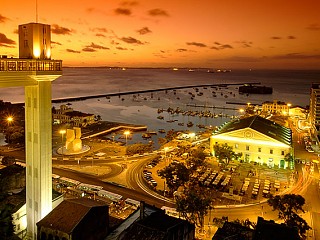Jericoacoara is a beach located in the northeast of Brazil, close to the equator, in the state of Ceará. It was, till about 15 years ago, an isolated fishing village, without any contact with modern civilization. There were no roads, no electricity, no phones, no TV, no newspapers, and money was something almost useless, since deals were based on trading fish for goods. In 1984 the place was declared an "Environment Protection Area" by federal law. Although tourism has reached the place, because of it’s extraordinary beauty, it still keeps the unhurried and peaceful way of life.
Because of the EPA law, it is forbidden to hunt, pollute, make roads, and buildings are limited to the village area (the EPA has 200 sq. km, and the village is 1 sq. km big) and have to follow the same architectural style. Lodging facilities had their construction forbidden in 1992, in order to limit the quantity of tourists in the place. The last 15 km on the way to Jericoacoara is soft sand, so you need a 4WD vehicle to get there. Until the beginning of 1998, electricity was supplied by diesel generators.
Today, there is an underground power supply, only for the houses. Street illumination still comes from the moon and the stars. In 1994, the North-American newspaper "Washington Post Magazine" chose Jericoacoara as one of the 10 most beautiful beaches of the world, in a special holiday issue.
Jericoacoara has more then one reason to be considered a paradise. The place is a set of several different sceneries, altogether in a very beautiful and harmonic combination. And not only to be seen, but to be felt. The intense contact with nature, and the sensation of freedom that the place transmits, where every place is so wide, and no kind of behavior is restricted, will mark Jericoacoara forever in your memories.
There are several activities for the visitor in Jericoacoara, to satisfy every taste. From calm hikes and horseback rides to radical sports, such as windsurf or sandboard. There are countless touristic interest sceneries, that sometimes it is hard to believe that they can be so different and be so close to each other.
What does the name "Jericoacoara" mean? Although there are several versions for the origin of the name "Jericoacoara", the most probable is that it is indigenous, from the tupi-guarani language: yuruco(hole) + cuara(turtle), meaning "hole of the turtles", in a reference to the fact that Jericoacoara is a beach where sea turtles come to make holes to lay their eggs. But some old fishermen do not agree with this version taken out of history books. They say that the name has its origin in the small hill beside the village (where the lighthouse is situated). The hill, when seen from high seas, has the shape of a laying alligator, which in a local expression would be "Jacareqüara", and with time the name ended up changing to Jericoacoara.
If you are the kind of person used to traveling to developed places, with comfort and several services for the tourist, then Jericoacoara is not the place for you. Until a few years ago, there were no lodges, restaurants, bars or shops. The several restrictions imposed by the EPA law for new buildings preserved several original characteristics of the place. In Jericoacoara you will not find luxury, but there are few lodges capable of receiving you in a clean and pleasant room, as well as some restaurants with delicious food. But if you are more concerned about knowing a very beautiful place, with intense contact with nature, then this is your paradise. Book more days than you think are necessary to get to know the place: the great majority of travelers end up delaying their departure, either because they feel that there is still a lot to be seen or because they want to enjoy more days in this unique and fantastic place.
Facts about Jericoacoara
- In 1985 Jericoacoara was a fishing village. Today it has a population of just over 2000 inhabitants. In 1984 it was elevated to APA (Environmental Protection Area). Today , the main economic activity is tourism , but always done in a way that preserves the region.
- The navigator Vicente Pizon , captain of one of the ships of Christopher Columbus landed in the waters of Jericoacoara in 1499. This record has not been formalized under the Treaty of Tordesillas which came into effect that year.
- The coastal environment has become extremely vulnerable and composed distinct landscapes, such as sand dunes, lagoons, mangroves and beaches.
- The fauna of this region is represented mainly by birds , cetaceans and fish populations. There are 38 families of birds on site and several species are rare or endangered.
- The climate is characterized by hot and humid, with rains from summer to autumn , with average temperatures ranging between 35 ° C and 22 ° C and the dry period ranging 5-6 months.
- The major tourist attractions of the region are the fields of dunes , beaches and the natural rocky outcrops of the crystalline substrate called Saw.






